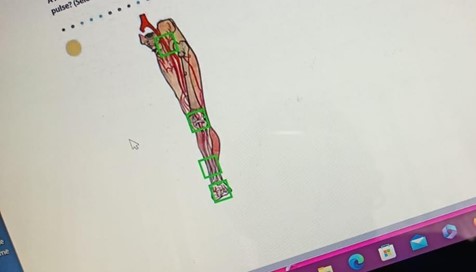A nurse is assessing a client's peripheral circulation. In which of the following locations should the nurse palpate to assess the posterior tibial pulse? (Selectable areas, or "Hot Spots," are outlined in the artwork below. Select only the outlined area that corresponds to your answer.)

inguinal canal
knee
lower third of the tibia
dorsal aspect of the foot
The Correct Answer is C
A. Inguinal canal is not the correct location for assessing the posterior tibial pulse. This area is associated with the femoral pulse.
B. The knee is not the correct location for assessing the posterior tibial pulse. This area is not directly related to the posterior tibial pulse.
C. The lower third of the tibia, anterior aspect is the correct location for palpating the posterior tibial pulse. This pulse can be found on the inside of the ankle, slightly below and behind the medial malleolus.
D. Dorsal aspect of the foot is where the dorsalis pedis pulse is located, not the posterior tibial pulse.
Nursing Test Bank
Naxlex Comprehensive Predictor Exams
Related Questions
Correct Answer is D
Explanation
A. Administering an analgesic by mouth (PO) may not provide immediate relief for the pain at the insertion site. It is more effective to address the issue directly by repositioning the IV catheter.
B. Requesting a prescription for a central venous access device is not necessary in this situation. If peripheral IV access is indicated, the nurse should aim to find a suitable site for insertion.
C. Administering a local anesthetic may not be necessary if the pain is solely related to the insertion of the IV catheter. Repositioning the catheter to a more comfortable site is a more appropriate first step.
D. If the client reports pain at the insertion site after the IV catheter has been placed, it may indicate that the catheter is not properly positioned or may be causing discomfort. In this case, it is appropriate for the nurse to remove the catheter and select a different site for insertion.
Correct Answer is ["A","C","D"]
Explanation
A. Education may influence the communication process to a significant extent as an interpersonal variable.
B. Time can affect communication in terms of available time for interaction, but it is not specifically related to interpersonal variables.
C. Perception refers to how individuals interpret and make sense of information. It is a key interpersonal variable that can influence how a message is received and understood.
D. Gender can be an interpersonal variable that affects communication. Different genders may have different communication styles and preferences.
E. Feedback is not considered an interpersonl ariation that can affect communication
Whether you are a student looking to ace your exams or a practicing nurse seeking to enhance your expertise , our nursing education contents will empower you with the confidence and competence to make a difference in the lives of patients and become a respected leader in the healthcare field.
Visit Naxlex, invest in your future and unlock endless possibilities with our unparalleled nursing education contents today
Report Wrong Answer on the Current Question
Do you disagree with the answer? If yes, what is your expected answer? Explain.
Kindly be descriptive with the issue you are facing.
